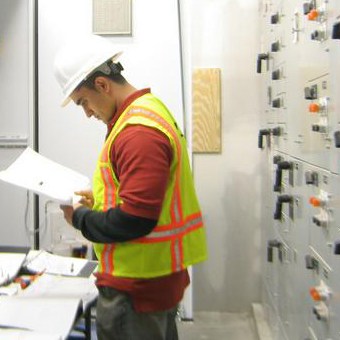To help you reach your full potential, I’ll discuss 9 powerful engineering mindset examples used by 10x engineers.
Not surprisingly, the benefits are plenty. Check out the below!
- Create amazing designs with fewer slip-ups
- Lead complex projects, and teams of diverse people
- Crush those tough engineering challenges
- Spot problems before they even think about showing up
#1 Keep an eye out for patterns and trends

Spotting patterns and trends in the following data can save you from a world of trouble:
- Calculation outputs
- Measured equipment data
- Observational data
Take SpaceX’s reusable Falcon 9 first-stage booster, for example. Even though it’s labeled “reusable,” engineers still give it a thorough check-up after each launch while refurbishing certain parts. They search for damage, especially any unusual wear patterns from one launch to the next.
This laser focus helps them predict future snags and beef up the booster’s weak spots. You don’t want a rocket going kaboom because someone ignored a certain wear pattern. Maybe a part of the rocket frame gets extra brittle after each launch, despite the detailed structural analysis.
Here’s another scenario: You’re reviewing historical data for a device and notice certain data trends upward without any obvious reason. You put on your detective hat and dig deeper before the equipment fails or someone gets injured.
The takeaway? Stay sharp and detail-oriented. When engineers slack off, problems are bound to follow.
#2 Pay attention to the unusual stuff
Be on the hunt for any anomalies in designs or finished products. When I do startup testing for hydroelectric plants, I expect some issues. But it’s the hidden ones that I need to watch out for, as they could come back to bite me.
Once, a generator roared loudly and shook like crazy. Sure, noise and shaking are normal, but this was off the charts. I knew something was fishy, so I stopped the testing right away and inspected the unit for any weird installation quirks.
If I had let the generator keep running, it could have been damaged or someone might have gotten hurt. The takeaway here is that experience is key. Nothing beats hands-on, real-world know-how.
#3 Make the most of existing work and designs
A lot of engineering is basically remixing what’s been done before. So, don’t try to reinvent the wheel. Think back to similar projects you’ve tackled or dig up others’ work to repurpose.
I recommend reusing as much old material as you can. Just make sure to adapt it to your new project and meet all the latest standards. This not only saves time but also means you’re using tried-and-true real-world solutions.
For instance, many people think SpaceX was the first to launch and land a reusable rocket. Surprise, surprise! They weren’t. In fact, the technology existed nearly 25 years ago. NASA’s McDonnell-Douglas DC-X proved this tech was legit.
The DC-X prototype rocket soared high and then landed vertically. NASA reused the rocket, and later, SpaceX came along, building on the existing tech. The result? SpaceX launching rockets into space and pulling off actual missions.
The bottom line is, nobody does everything from scratch. We all borrow from past discoveries and successes. That’s why engineers stand on the shoulders of millions of brilliant minds that came before us.
#4 Dive deep into the nitty-gritty of projects

When tackling a problem, the more you immerse yourself in the details, the better solutions you’ll find. In engineering, overlooking even a tiny bit of information can throw off your entire design.
Imagine an autonomous Tesla vehicle, equipped with:
- 8 cameras for 360° visibility up to 250 meters
- 12 ultrasonic sensors to detect hard and soft objects
- 1 forward-facing radar
These sensors gather data for near-autonomous driving. Although still a budding technology, if you were to give a human driver this sensor coverage, accident rates would plummet.
For instance, a driver might forget to check left at an intersection, missing crucial data from that side of the road. This oversight could lead to a disastrous accident. To avoid such situations, gather as much data as possible, in this case, using the Tesla detection hardware. Here’s how to amp up your problem-solving game:
- Chat with fellow engineers about their design choices that affect you
- Examine calculations and grasp the underlying concepts
- Conduct reality checks to consider all real-world variables
- Probe clients for in-depth information about their project
- Collect all existing project drawings, specs, reports, and data
#5 Analyze the tradeoffs between all solution options
Don’t just settle for the first design idea that comes to mind. Instead, ponder all your options and balance their advantages and disadvantages. Take rocket design, for example. Engineers face numerous tradeoffs involving:
- Propellent type
- Outer frame material type
- Aerodynamic shape
- Safety factor
- Number and type of rocket engines
Each variable impacts cost, lead time, mission types, and reliability. Doubling a rocket’s safety factor nearly doubles the propellant, as more material adds weight.
Alternatively, using a lighter yet sturdier material could increase costs, potentially pricing out some customers. Every engineering decision involves tradeoffs, so engineers must weigh them carefully to make the best design choices.
#6 Team up with experts to level up
In engineering, it’s impossible to learn everything on your own. There just aren’t enough hours in the day, and the field is vast. Plus, hands-on experience is vital for developing skills, which is a huge time commitment.
But here’s a shortcut…
Take SpaceX, for example. Elon Musk founded and financed the company, gathering the brightest aerospace minds he could find. This not only benefited SpaceX but also accelerated Elon’s own learning. He absorbed knowledge from industry leaders, constantly picking their brains.
Remember, Elon didn’t have a formal education in rocket engineering—he’s self-taught.
#7 Learn how to communicate with people of all backgrounds
Let’s be real, communication often takes a back seat in the engineering world. Hollywood’s portrayal of engineers as antisocial hermits doesn’t help, as it makes some new engineers believe that such behavior is acceptable.
Truth is, communication is a big deal in engineering, and I don’t just mean talking but writing as well! As an engineer, I’m always connecting with co-workers and clients, and I’m forever typing out emails or drafting technical specs.
It can be frustrating when I feel like I have to pry information out of my fellow engineers. Honestly, I couldn’t care less about the delivery style – even if it’s as monotone as a robot! Just communicate with me.
And it’s not just me being bugged; lousy communication can genuinely wreck projects. Remember point #4 about gathering data? Communication is how we pass that data around between us humans.
Think about this: solid communication could’ve saved the Mars Climate Orbiter. That mission failure cost NASA a whopping $125 million. The connection between Lockheed Martin and NASA was sketchy at best, leading to a mix-up between metric and English units. According to an IEEE Spectrum investigation, the engineering teams had grown lazy:
“A critical flaw was a program management grown too confident and too careless, even to the point of missing opportunities to avoid the disaster.”
Better communication might’ve nixed the lousy management. Someone might’ve spoken up about the less-than-stellar working conditions. That’s why I reckon most engineering flops start with crummy communication.
To boost your communication skills, take a gander at my other articles:
- Master engineering email writing using these 14 tips
- 12 engineering writing tips you need to know
- Engineering writing style guide – 6 things to know
- 12 ways to improve public speaking skills for engineers
#8 Keep one eye on the future when designing
Don’t just design for today. Look ahead and try to guess the future variables, so your design won’t become outdated or cause unnecessary headaches.
For instance, I often design water pump stations. But I don’t just design them for current demand unless I’m told to. I peer into the future and estimate what a city will need in 5 to 10 years. That way, the pump station won’t become useless in a flash. Imagine shelling out tens of millions of dollars and then, five years later, you’re back where you started.
Lately, I’ve also been designing with climate change in mind. If temperatures are rising in an area, I factor that into my design. Because from the start of the design process to construction completion, it can take 4 to 5 years. Honestly, I’d say it’s bad engineering if you don’t think about stuff like that.
#9 Stay hungry for knowledge

No matter how much you study, there’s always more to discover. And the cool thing is, learning only makes you a more interesting person.
Today, we’ve got Google at our fingertips, giving us endless info on tap. The trick, though, is to really understand what you learn. Then, figure out how to use those concepts in the real world while making as few mistakes as possible.
Take computer programmers, for example. Many of them patch together apps using code snippets they find on Google. It works great if you actually understand the code you’re copying. But more often than not, it leads to a tangled mess of spaghetti code because the programmer doesn’t know what they’re doing.
What’s even more concerning is that these coders inevitably hit a brick wall when they need to create fresh, groundbreaking apps. The lesson here is to steer clear of blind shortcuts. Instead, ignite passion in your work and strive to learn the fundamentals and beyond. Otherwise, you’ll eventually slam into that wall, and your growth as an engineer will come to a screeching halt.
Learning from engineering mindset examples
Use these engineering mindset examples to level up as an engineer. In return, you’ll design better, make better engineering decisions, and gain confidence. I wholeheartedly believe this will lead you to a more awesome career, while feeling more fulfilled. A win-win!
Which of the engineering mindset examples do you think is the most important? What do you find to be the best way to level up?

Author Bio: Koosha started Engineer Calcs in 2019 to help people better understand the engineering and construction industry, and to discuss various science and engineering-related topics to make people think. He has been working in the engineering and tech industry in California for well over 15 years now and is a licensed professional electrical engineer, and also has various entrepreneurial pursuits.
Koosha has an extensive background in the design and specification of electrical systems with areas of expertise including power generation, transmission, distribution, instrumentation and controls, and water distribution and pumping as well as alternative energy (wind, solar, geothermal, and storage).
Koosha is most interested in engineering innovations, the cosmos, sports, fitness, and our history and future.
